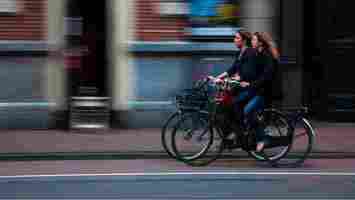Volvo’s sleek concept car teases its new EV design language
To date, Volvo’s electric models have been using conventional automobile architecture designed for internal combustion engines. In other words, EVs look like petrol-powered cars.

But now the Swedish car maker is ready to update its own design language and philosophy, and introduce us to next generation electric vehicles.
On Wednesday, the company unveiled the Volvo Concept Recharge SUV and, boy, is it elegant and beautiful. Designed to be the “manifesto” for next-gen all-electric vehicles, the concept car embodies Volvo’s new motto: “less but better.”


First, forget about the battery pack under the hood. The powertrain is now placed under the flat floor, which allows for an elongated wheelbase.
This results in a bigger interior space, including a large storage area between the front seats, but also leads to shorter overhangs, a lower hood, and a optimized roof design.
According to the company, this approach improves aerodynamic efficiency, which in turn provides a longer range.
The Concept Recharge also introduces a new Volvo design language that removes all “unnecessary elements.” Its styling is more streamlined and simple than current models, while its interior is stripped back, aiming to echo the feeling of a “Scandinavian living room.”
Robin Page, Senior Vice President of Design, explained:
In line with this vision, the concept car features a 15-inch infotainment touchscreen, “designed for intuitive and logical use that helps provide a calm experience.”
Finally, t he car includes a a roof-mounted LiDAR sensor. This enables data collection around the vehicle, as well as allowing Volvo to enhance its autonomous driving technology in the coming years.
Unfortunately, there’s no indication whether the Concept Charge will actually evolve into a production car, or when we can expect to buy a next-gen Volvo EV based on this blueprint.
Be that as it may, I have personally recharged my expectations of Volvo. It remains to see if the “less is more” philosophy will attract SUV buyers, who usually look for the “something extra.”
Do EVs excite your electrons? Do ebikes get your wheels spinning? Do self-driving cars get you all charged up?
Then you need the weekly SHIFT newsletter in your life. Click here to sign up .
Oh, great — Uber and Lyft are actually increasing car ownership in US cities
Ride hailing apps like Uber and Lyft were created with a Silicon Valley mindset to “disrupt,” and change how we travel, supposedly for the better. The platforms were supposed to provide alternatives to private car travel and ultimately decrease car ownership.

However, a recent study suggests that this isn’t entirely the case and ride hailing apps actually increase car ownership, especially in cities that are already dependent on cars.
Researchers from Carnegie Mellon University, Stanford University, the National Renewable Energy Laboratory, and Lawrence Berkeley National Laboratory, concluded that services like Uber and Lyft increase private car ownership by an average of 0.7% in urban US areas.
According to Streets Blog USA , that equates to around 100,000 extra vehicles on US roads.
In New Scientist , Jeremy Michalek, the study’s lead author, said:
But when Uber and Lyft enter a new market, it actually increases vehicle ownership. Increases were most pronounced in car dependent cities, which already display higher than average private vehicle ownership.
These cities experienced a 1% increase in private vehicle ownership.
The researchers aren’t exactly sure why this is occurring, though. They speculate that ride-share app users are becoming drivers themselves, and buying cars to get into the business. Or, people who already own a car, are buying a second vehicle to use exclusively as a ride hail taxi.
We know from various global reports , that when Uber and Lyft launch in new markets, drivers often buy new vehicles to use specifically for the ride-share services. Uber also actively helps individuals interested in joining its service to buy or lease a new car. So this speculation is well measured.
The effects of ride-share platforms were still felt in cities that didn’t display a significant rise in car ownership.
In cities like Seattle, Boston, and San Francisco, which have a disproportionately high density of high-income childless households, public transit systems took a hit.
Transit users were found to substitute their use of public transport in favor of an Uber of Lyft, because they can afford to, but they weren’t necessarily getting rid of their cars.
Whether this leads to an increase in emissions and congestion would require further research, Michalek says.
There are studies that suggest it does indeed increase congestion and emissions .
It seems reasonable that if 10 people each use an Uber instead of one bus, that’s more emissions and congestion per capita than if they’d all just stuck to the bus.
It’s not exactly the utopian city vision we were promised.
Next time you’re firing up that ride-sharing app, ask yourself, is there a better, more efficient way of making your journey?
SHIFT is brought to you by Polestar. It’s time to accelerate the shift to sustainable mobility. That is why Polestar combines electric driving with cutting-edge design and thrilling performance. Find out how .
If we make cities safer for women, everyone benefits
This article was originally published by Sarah Wray on Cities Today , the leading news platform on urban mobility and innovation, reaching an international audience of city leaders. For the latest updates follow Cities Today on Twitter , Facebook , LinkedIn , Instagram , and YouTube , or sign up for Cities Today News.

New research from Ramboll finds that personal safety concerns about walking, cycling and using public transport have a big influence on how women move around cities.
The Gender and (Smart) Mobility report calls on cities and transport planners to adopt a safety by design approach and apply a gender lens to all projects without casting women as victims. This, it says, is the key to making all citizens feel safer.
The analysis brings together existing local and national gender-segregated transport behavior data with a survey of 3,525 people and focus groups across seven capital cities – Helsinki, Oslo, Copenhagen, Stockholm, Berlin, New Delhi, and Singapore.
Marianne Weinreich, Market Manager, Smart Mobility, Ramboll, told Cities Today : “This report confirms that transport is not gender neutral. There is plenty of data and research, but it’s the best kept secret in the transport industry and often is not used in projects.”
“Women are not a minority but are treated like that unconsciously in this sector, which is dominated by men,” she added. “We need to create awareness but also systems that challenge these biases.”
COVID safety
The research finds that women associate COVID-19 with public transport more than men. “Since women use public transport more than men, this creates a real risk of growing inequalities as places open up and movement levels return in our cities,” the report says.
Women also identified personal safety and fear of harassment and assault as a concern in relation to public transport more often.
In the survey, 64 percent of women compared to 57 percent of men said the distance to a station or stop from their home influences their choice of public transportation. A third of women are influenced by whether they feel secure at the station (33 percent) and on-board transport (35 percent), compared to 28 percent and 29 percent of men respectively.
In focus group interviews, women from across geographies also expressed concerns and fears around waiting at bus stops and train stations. They reported that the design of public space, stops, stations and platforms and whether there are staff available influences how secure they feel.
Walking and cycling
Women were also found to walk more than men but again indicate personal safety and concerns about harassment and assault as a challenge, as well as travelling with groceries and bags.
Across all the geographies, women reported various methods of dealing with fear when walking at night – from staying away from certain areas, not staying out too late and choosing shoes they can run in, to carrying their keys in between their fingers in their pocket as a potential weapon.
“It was astonishing that independently of each other these women from across seven capitals in many cases used the exact same wording for describing the strategies that they use,” Weinreich said.
The report comes as the disappearance and death of Sarah Everard in London last month has sparked debates about women’s safety in public spaces. Reports said that downloads of women’s safety apps such as WalkSafe and Hollie Guard also surged after Ms Everard went missing while walking home and her body was later discovered. A murder trial is scheduled for autumn.
Ramboll’s research finds that when it comes to cycling, 26 percent more women than men indicate “traffic safety” as a challenge. A sense of ‘not feeling safe’ was identified in the international research, by local experts and by the women in the focus groups.
In all capitals except Copenhagen, the lack of safe cycling infrastructure is seen as a barrier. Even in Copenhagen, as well as Oslo, women in the focus group interviews highlighted “lycra guys”, who cycle very fast, as an issue.
Safety by design
The report stresses that cities and transport planners shouldn’t “victimize” women, but urges them to include safety and security in the design of all solutions – not as an add-on but as an integral part of the project.
“This is about having a lens that focuses on women’s needs but if you cater for those considerations, you actually create better mobility for all,” said Weinreich. “If we cannot facilitate and include women’s needs, who make up half the population, then we are really challenged in delivering inclusive design for minorities.”
The study also recommends collecting gender-segregated data in planning and design and analyzing data through a gendered lens.
Ramboll’s report was developed in partnership with the Ramboll Foundation and transport agencies Helsinki Region Transport (HSL), Region Stockholm and Trafikverket in Sweden, and VBB in Berlin, Germany.
Do EVs excite your electrons? Do ebikes get your wheels spinning? Do self-driving cars get you all charged up?
Then you need the weekly SHIFT newsletter in your life. Click here to sign up .